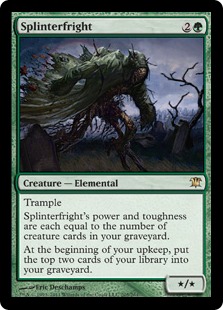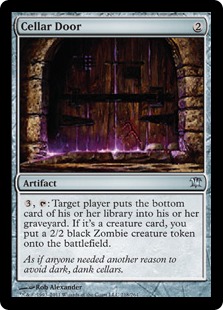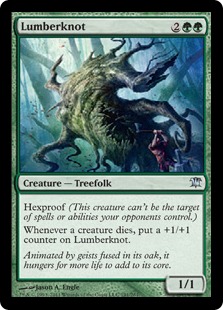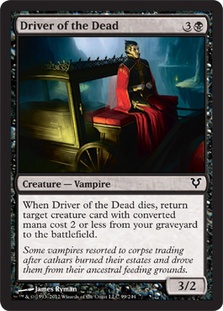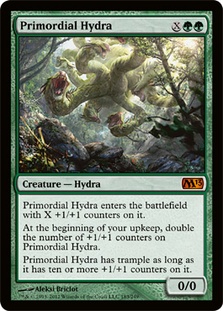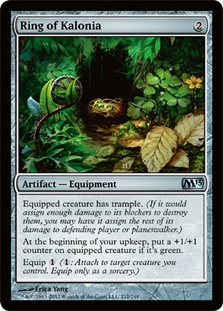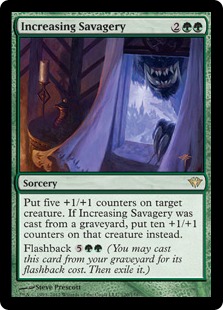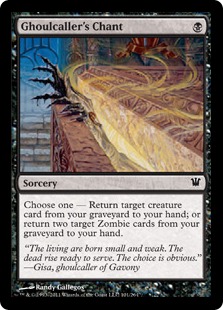Man, the previews for Return to Ravnica have gotten me all worked up, and I was originally going to babble on and on about some of the new cards here. But then I figured well, that’s what a lot of other people are going to do, and then of course there will be set reviews soon… I thought what might be helpful to both me and you would be to dig into the current Standard card pool that will survive the rotation and see what’s lurking down in the lower tiers that might provide nutrients for the next competitive decks to grow in the Ravnica sunshine.
Even narrowing the focus in such a way would probably prove to be a rather lengthy treatise, so I’m going to focus on potential Golgari strategies because:
- Golgari is awesome!
- I love black and green.
- Golgari is awesome!
- The color combination gets love in Return to Ravnica (rather than having to wait for Gatecrashlike the stepchildren guilds) and so will likely have the mana and tools it needs to pull a strong strategy together.
- Golgari is awesome!
- Did I mention I love black and green?
Golgari Swarm
Over on GuildsofRavnica.com, if you click on Golgari (and why would you click on any other guild?), you’ll find these clues to digest:
The Golgari Swarm fuses the opposite values of life and death, fostering growth in Ravnica’s decaying communities but also fostering decay in places of growth. The elves, zombies, insects, and undead/plant hybrids of the Golgari are like one massive growing, feeding organism, collectively spreading across the plane wherever they can fit. The Golgari provide a necessary service in Ravnica: they dispose of the carcasses civilization leaves behind, and mysteriously they also provide sustenance for the forgotten and the needy. They are the scavengers and decomposers at the fringes of the food chain, but yearn to be the predators at the top.
The Golgari guild is organized more like a single organism than a collective. It has a nucleus or nerve center that drives the direction and growth of the guild, elements that collect nutrients and convert them into usable resources, defenses that fight off foreign bodies, and an instinctual drive to survive, reproduce, and overcome.
The Golgari are ruled by the lich guildmaster Jarad, but beyond that the ruling structure can be hard to detect. Jarad maintains a council of shamans and rogues called the Cilia, who act as a combined advisory parliament and spy agency but rarely convene publicly or come together at once. Insect minions act as a sensory apparatus to know what the outer reaches of the Golgari are doing an as a messenger service to deliver instructions. Some individuals may be considered to have higher rank than others, but no one beyond the guildmaster knows those rankings. The Golgari guild has had more changes in leadership than any other guilds. The guild believes in the importance of continuous cycles, understands that assassination is a valid means of political conquest, and knows that being alive is not a prerequisite to rule.
Korozda is the new Golgari guildhall, an arched cathedral surrounded by an immense, circular maze of overgrown, fungus-encrusted ruins. Korozda is the lair of guildmaster Jarad and the place where he meets with his irregular court of attendants. It’s patrolled by an array of swarming vermin, giant insects, and zombies.
My big takeaway here is that we’ll be seeing more Elves and Zombies, two tribes that have some support cards that survive the rotation.
In Ken Nagle’s article "On the Origin of Scavenge and Overload," he said:
The Golgari are the necromancers of Ravnica, viewing death as just another way to grow in strength. Their previous mechanic was dredge, which works from and fuels the graveyard, allowing you to draw the same card over and over.
A large graveyard is the Golgari player’s best friend. Now that we are returning to Ravnica, we wanted to keep the Golgari’s large graveyard but design a new mechanic that’s less repetitive.
Thanks to scavenge, Golgari plays as the "large creature" guild in Return to Ravnica, trading to survive early and taking over the late game with a large graveyard filled with scavenge-able corpses. So keep an eye out when you return to Ravnica, because the Golgari will be scavenging the dead rather than digesting them—and now you’ll know why.
Okay, so we’re still going to want to take advantage of our graveyard, and the more cards in there the better—especially since using scavenge actually shrinks our graveyard. Also, scavenge appears to be designed to let us "survive early and [take] over the late game."
The "Return to Ravnica Mechanics" article on Daily MTG had this to say in describing the scavenge mechanic:
You can activate the scavenge ability of a creature card in your graveyard any time you could cast a sorcery by exiling it and paying its scavenge cost. That lets you put a number of +1/+1 counters equal to the scavenged creature’s power onto a target creature.
While Sluiceway Scorpion is on the battlefield, scavenge doesn’t do anything. It’s once it dies (or gets into your graveyard some other way, such as by being discarded) that things get cool. Any time it’s in your graveyard and you could cast a sorcery—i.e., during your main phase when the stack is empty—you can pay 1BG mana and exile Sluiceway Scorpion to put two +1/+1 counters on a target creature, because Sluiceway Scorpion’s power is 2. (There’s at least one scavenge creature with a power that changes while it’s in your graveyard, but Sluiceway Scorpion’s power is always 2 when it’s in your graveyard.)
You can’t activate a scavenge ability unless there’s a creature you can target with it. If you activate a scavenge ability targeting a creature and then the creature leaves the battlefield or becomes an illegal target some other way (say, by gaining protection from one of the scavenged card’s colors), the creature won’t get any counters, but the creature card you scavenged will still be exiled.
So scavenge is "slow," which means you’re vulnerable to tempo plays like killing or bouncing the creature you’re spending mana on. We’re already used to this to some degree from playing with equipment, but scavenge leaves us a bit more vulnerable since the resource—the card you’re scavenging—is exiled when you use it. That means we’ll want to make sure the guys we’re using scavenge on are more resistant to tempo plays, so hexproof becomes the obvious ideal pairing with scavenge.
We also know that Wizards likes to seed cards and strategies for upcoming sets into sets released earlier, so let’s keep an eye out for that sort of thing while we’re strolling through Innistrad and M13 looking for diamonds in the compost pile. Keep in mind that we’ll have an entirely new and different metagame once Return to Ravnica hits, and cards that are unplayable now will deserve a fresh evaluation.
Okay, let’s get digging! Don’t mind the corpses, they help our gardens grow…
Creatures in the Graveyard
Okay, so to take advantage of Golgari power we’re going to want creatures in the graveyard. What are some cards that survive the rotation that play with that theme?
Wreath of Geists, Boneyard Wurm, Splinterfright
Jarad himself gets bigger and deadlier the larger he is, and there are these cards in Innistrad that do the same. Indeed, Splinterfright even feeds the graveyard too. If we can really stock up the graveyard—and there are cards like Tracker’s Instincts, Mulch, and Forbidden Alchemy along with the new RTR card Putrid Salvage that give us a ton of ways to do so—these cards along with Jarad can become quite deadly.
Kessig Cagebreakers, Spider Spawning, Gnaw to the Bone
Bigger creatures aren’t the only way we can benefit from a graveyard stocked with creatures. The sheer creature advantage you can generate with Kessig Cagebreakers and Spider Spawning can seriously clutter up the ground, and the life swing from Gnaw to the Bone (after flashback) can really put the game out of reach.
I’ve dabbled around with ways to give the Cagebreakers haste before because odds are pretty good that your opponent will do their best to kill him either on your turn or his own, so I’ve got my fingers crossed there might be a good way to do so in the new metagame. Unfortunately, the biggest problem with Cagebreakers might be its casting cost, which bumps right up against the supremely awesome Thragtusk.
Cellar Door, Grimoire of the Dead, Trading Post
There are a few artifact graveyard enablers of note. With Day of Judgment rotating out, I expect more and more control mages turning towards the wicked and evil Terminus as their default creature sweeper. Seriously, what sick and twisted individuals thought it would be funny to lock a bunch of creatures in the bottom of a library? Just kill them honestly and let their bodies be useful. Anyway, with enough folks running Terminus I predict Cellar Door getting some love as a nice countermeasure that can also just randomly enable your graveyard strategy.
The love for Trading Post will likely die down quite a bit with our latest artifact block rotating out of Standard (sigh, Wurmcoil Engine and Phyrexian Metamorph, we’ll miss ye and others)…but the card might make some noise due to its ability to pitch a card for life. We want to survive long enough to use our graveyard as a resource? This ability does both. We’ll likely need a couple more artifact cards worth playing to push Trading Post into playability, but I don’t think we should be so quick to retire Trading Post just yet. Similarly, Grimoire of the Dead can pitch creature cards from the hand and potentially take advantage of your opponent if they’re pursuing the same strategy.
Dies
If we want creatures in the graveyard, the most common way to do that is for them to die from the battlefield. What cards can either help us do that better or take advantage of the dying?
Tragic Slip, Blood Artist, Falkenrath Noble, Lumberknot, Harvester of Souls, Jar of Eyeballs, Gutter Grime
The morbid keyword obviously loves to see creatures dying, and in the Golgari colors there’s no better morbid card than Tragic Slip, which is just phenomenal removal. Blood Artist has already proven itself a potent finisher in Zombie decks, but I could see it branching out into other Golgari strategies, perhaps with the similar Falkenrath Noble.
Lumberknot is a card that barely got any Limited love… But it’s got hexproof and gets bigger when creatures die, which is perfect synergy with what scavenge appears to be pushing us towards. Still, it’s expensive and starts really small, so it’ll be interesting to see if conditions will line up where this card crosses over the playability line.
Grim Backwoods, Altar’s Reap, Bloodthrone Vampire, Disciple of Griselbrand, Bloodflow Connoisseur, Demonlord of Ashmouth, Garruk Relentless, Disciple of Bolas, Feed the Pack
We want ways to make creatures die; we’ve got ways to make creatures die! I’m particularly curious about Bloodthrone Vampire and Bloodflow Connoisseur—while they’re both vulnerable to tempo plays, they also can utilize scavenge for some explosive plays. If there’s an aggro Golgari strategy, these Vamps may be a key part of it.
Young Wolf, Butcher Ghoul, Black Cat, Strangleroot Geist, Treacherous Pit-Dweller, Geralf’s Messenger, Driver of the Dead, Evernight Shade, Bitterheart Witch, Vorapede; Mikaeus, the Unhallowed, Moldgraf Monstrosity
Those about to die, we salute you! While we’ll want to get scavenge creatures in the graveyard, if we don’t have enough quality scavenge cards we might want to fill out with other candidates that are happy to be die. Innistrad gave us some nice creatures that have "dies triggers," and of course undying guys love to die the first time around so they get bigger. There’s some tension there because you can’t take advantage of undying if you have a +1/+1 counter on it and the scavenge ability adds +1/+1 counters. It’ll be interesting to see whether that tension keeps undying and scavenge from playing nice together.
+1/+1 Counters
Scavenge throws around +1/+1 counters, so what cards do we already have that play into that?
Champion of Lambholt, Predator Ooze, Unbreathing Horde, Primordial Hydra
Champion of Lambholt has already popped up on occasion as Green Sun Zenith targets to let your creatures rush through weenie blockers unblocked, and it can grow +1/+1 counters on its own…but Scavenge can really push it much further and harder. Predator Ooze makes its own counters too, but being indestructible is a close second to hexproof as a nice candidate for Scavenge counters.
Unbreathing Horde hasn’t gotten much love yet in Constructed—not even in Zombie decks—but if there are a lot of scavenging Zombies that might change. Primordial Hydra is a casual favorite, but its ability to double +1/+1 counters it could get from Scavenge—along with trample potential—might make it worth considering.
Rancor, Ring of Kalonia
Speaking of trample, we’re going to want to actually translate all those scavenged +1/+1 counters into damage dealt to our opponent, and with chump blockers abounding trample is a great way to push that damage through. Rancor will likely play a big role in scavenge strategies, and Ring of Kalonia might even see a little play.
Gavony Township, Increasing Savagery
Of course, scavenge isn’t the only +1/+1 counter game in town, and these two cards might supplement the strategy where appropriate.
Tribal
Ghoulcaller’s Chant, Gravecrawler, Diregraf Captain, Elvish Archdruid, Endless Ranks of the Dead, Zombie Apocalypse
Checking what survives the rotation, there’s not much in the way of Elf support—though some good Elves remain, so it’s possible (though I think unlikely) that we might get some Elf tribal stuff in Return to Ravnica. There are some decent Zombie tribal cards in Innistrad that will much more likely play nicely with our new Golgari cohorts.
The Golgari Way
Wizards keeps previewing some fantastic Golgari cards, and it’s funny—I keep hearing people talk about them in context of BUG decks, or Jund Decks, or "splashing" the green/black cards into their control strategy of choice. "Why not—mana is going to be so easy!" Why not isn’t the question that comes to my mind; instead, the question is why bother?
As I write this the set has barely been spoiled, and I’m already seeing a strong black and green deck coming together around cards like Abrupt Decay, Thragtusk, Bloodline Keeper, Elvish Visionary, Gatecreeper Vine, Vraska the Unseen, Murder, Garruk Relentless and Tragic Slip…and I haven’t even seen the Golgari Charm yet! I have no doubt that it will indeed be "easy" to fix mana and splash in the Golgari cards, but I also know that straight up Golgari mana is going to be rock-solid between Overgrown Tomb, Woodland Cemetery, Cavern of Souls and maybe even Golgari Guildgate, so…
Why bother tainting the Swarm with other colors, other guilds? We have strong planeswalkers and plenty of power cards to defeat our foes by staying pure!
For some reason whenever I think about Golgari, this quote creeps into my head:
Only death…pays for life.
Take care,
Bennie
starcitygeezer AT gmail DOT com
Make sure to follow my Twitter feed (@blairwitchgreen). I check it often so feel free to send me feedback, ideas, and random thoughts. I’ve also created a Facebook page where I’ll be posting up deck ideas and will happily discuss Magic, life, or anything else you want to talk about!
New to Commander?
If you’re just curious about the format, building your first deck, or trying to take your Commander deck up a notch, here are some handy links:
- Commander Primer Part 1 (Why play Commander? Rules Overview, Picking your Commander)
- Commander Primer Part 2 (Mana Requirements, Randomness, Card Advantage)
- Commander Primer Part 3Â (Power vs. Synergy, Griefing, Staples, Building a Doran Deck)
- Commander Starter Kits 1 (kick start your allied two-color decks for $25)
- Commander Starter Kits 2 (kick start your enemy two-color decks for $25)
- Commander Starter Kits 3 (kick start your shard three-color decks for $25)
My current Commander decks (and links to decklists):
- Nefarox, Overlord of Grixis (evil and Spike-ish)
- Yeva, Nature’s Herald (living at instant speed)
- Johan (Cat Breath of the Infinite)
- Riku of Two Reflections (steal all permanents with Deadeye Navigator + Zealous Conscripts)
- Phelddagrif (Mean Hippo)
- Sigarda, Host of Herons (Equipment-centric Voltron)
- Bruna, Light of Alabaster (Aura-centric Voltron)
- Niv-Mizzet, the Firemind (Chuck’s somewhat vicious deck)
Previous Commander decks currently on hiatus:
- Ruhan of the Fomori (lots of equipment and infinite attack steps)
- Phage the Untouchable (actually casting Phage from Command Zone!)
- Ghave, Guru of Spores (Melira Combo)
- Glissa, the Traitor (undying artifacts!)
- Grimgrin, Corpse-Born (Necrotic Ooze Combo)
- Damia, Sage of Stone (Ice Cauldron shenanigans)
- Geist of Saint Traft (Voltron-ish)
- Glissa Sunseeker (death to artifacts!)
- Jor Kadeen, the Prevailer (replacing Brion Stoutarm in Mo’ Myrs)
- Thelon of Havenwood (Campfire Spores)
- Melira, Sylvok Outcast (combo killa)
- Konda, Lord of Eiganjo (The Indestructibles)
- Vorosh, the Hunter (proliferaTION)
- Progenitus (Fist of Suns and Bringers)
- Savra, Queen of the Golgari (Demons)
- Uril, the Miststalker (my "more competitive" deck)





